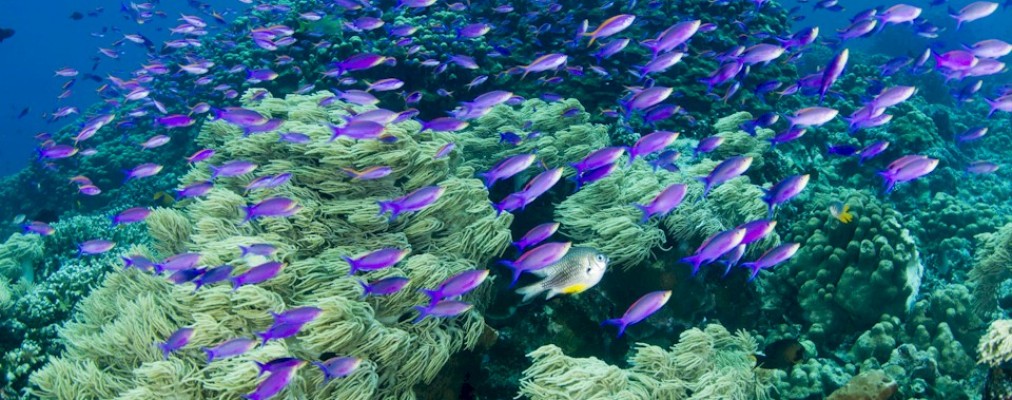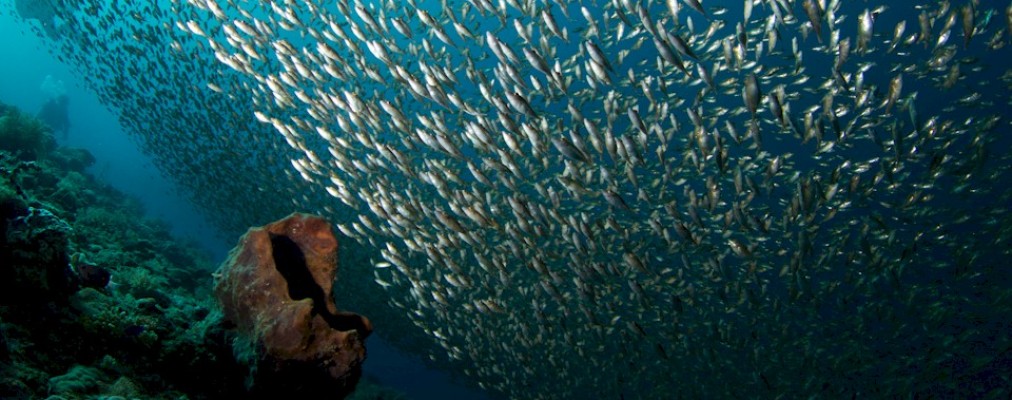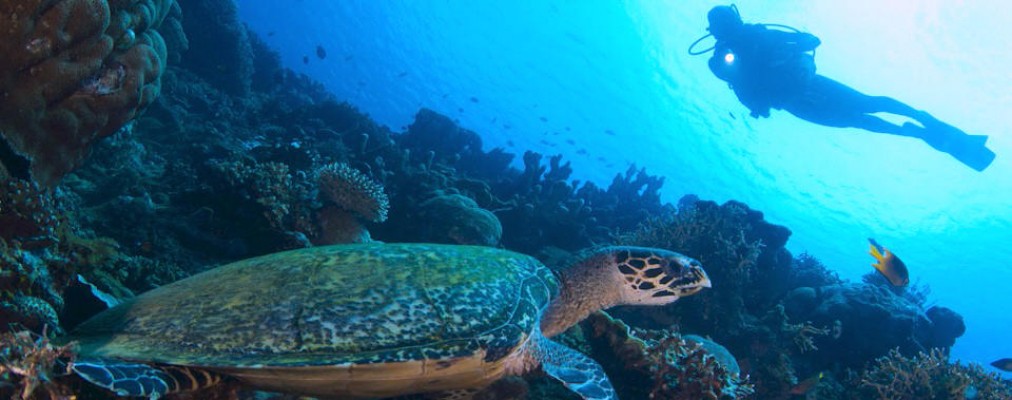Loading content - please wait...
Wall Diving Indonesia’s Hidden Paradise
Wall diving Indonesia offers many wonderful choices. Asian Diver magazine has called Gorontalo “Indonesia’s hidden paradise.” Wall diving here is world-class. Guests of Miguel’s Diving dive along the continental tall of Sulawesi. Here deep oceans meet limestone walls covered in hard corals. Below are are a few wall diving Indonesia sites found in Gorontalo.
Chimneys Dive Site
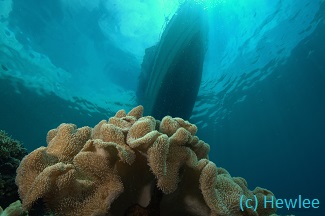
This dive site is rarely dived because of its distance from Gorontalo City. Unlike wall diving Indonesia found elsewhere, the wall here has about 20 vertical cuts. They are deep, narrow and straight. They begin at the shallow reef crest and plunge down the wall. Only a few of these channels are wide enough for a diver to enter. Most are too narrow. Miguel’s Diving calls them “chimneys.” Many are full of a unidentified species of Gorgonian white fan. They obviously thrive in the protected environment inside these chimneys. More large Gorgonian sea fans are found here than at other dive sites in Gorontalo. This includes pale colored ones not found elsewhere. Another feature of this dive site is dramatic vertical drop, a feature of wall diving Indonesia. Bumphead parrotfish (Bolbometopon muricatum) and Pinnate batfish (Platax pinnatus) like this site.
This site is about 550 meters long.
Depth: 0 – 40 meters
Wall Diving Indonesia Highlights from Gorontalo: a few caves, narrow chimneys clogged with white fans, deep lower wall, numerous gorgonians.
Conditions: Visibility at this site rarely exceeds 18 meters. Sometimes, it is irritatingly cloudy after high winds or heavy surf. Its proximity to the point jutting farthest into the sea means it lies just off the equator. Wall diving Indonesia is available on both sides of the equator. Currents here can be unpredictable. Cold up-wellings and down currents are most noticeable at new moon and full moon. Any wind will usually make this site unreachable.
Virtual Wall Diving Indonesia in Gorontalo
Diving at an 18-meter depth, notice the wall’s many narrow chimneys as you pass five bends. The wall straightens after the sixth bend. Below is a very narrow shelf. It is edged in deep black water. Experienced divers may wish to start their dive here at the limit of no-decompression diving. Peer down the dark face of the lower wall. Investigate the cavern tucked above the shelf and search for creatures of the deep like passing tuna.
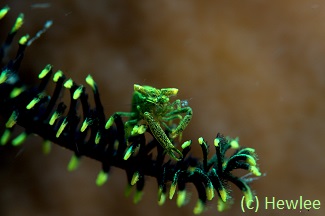
On the wall’s mid to upper levels, notice the high number of gorgonian sea fans. Next is a chimney large enough for a single diver to enter. The interior of this chimney is covered with tiny white fans. After another 100 meters, the wall is scarred by numerous fissures. Enjoy the quick succession of ten chimneys, most crowded with tiny white fans. Only the first one is large enough to enter.
Sunlight floods these fan-filled chimneys. Wall diving Indonesia here features some colorful Dendronephthya soft coral. After your dive, ask the dive master to find the smurf blue coral. A single example of iridescent blue branching Acropora grows on the reef crest. This unusual coral is more typically found in coral gardens in west Gorontalo in Tomini Bay. Northern Sulawesi, including Gorontalo, is home to over 500 species of hard coral. That is part of the rich experience when wall diving Indonesia.
Silvertip Grounds Dive Site
Diving this wall site pits the smallness of the human frame against an imposing wall, towering caverns, huge sponges, large marine life and often ripping currents. The shallow coral reef here is extremely narrow. In many places it measures only about a meter wide! The coral wall begins at between three to five meters. It bottoms out in the 30 to 40 meter range. A shelf hugs the bottom of this upper wall and descends sometimes gently and sometimes steeply to the second wall. This lower wall drops off into the deep to 120 meters.
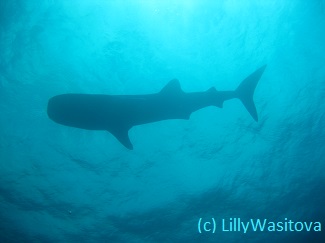
Miguel’s Diving staff surveyed this wall in 2000. At that time a Silvertip shark (Carcharhinus albimarginatus) routinely patroled this shelf. That is where the dive site name comes from. Several tall caverns tower above the shelf. The ever-bending wall is much smoother than other Gorontalo wall dive sites. Along several lengths of wall, the current has deposited parallel bands of sand.
This site is about 350 meters long.
Depth: 3 – 40 meters
Wall Diving Indonesia Highlights from Gorontalo: imposing wall, towering caverns, huge sponges, large marine life, excellent coral growth and lots of fish
Conditions: Typical visibility is 20 meters. On occasion, that can double. Expect currents. Remember: the faster the current the more fish! Travel with a boat crew like our staff at Miguel’s Diving who know local conditions. Winds from certain directions can dramatically impact surface conditions and currents during the course of a dive. Heavy surf from sudden winds can cause significant down currents in some places.
Special Note: This is a site for advanced divers or those experienced in current diving. Make sure to follow your guide in case swimming against the current becomes too difficult. The wall has many sharp bends, which affect the current. Divers may ride the current and swim against it during a single dive. Currents here also ebb and flow. If possible, wait for five minutes in a protected spot, then try again to round the bend and swim against the current. If the current has not subsided within five to ten minutes, it is not likely to do so during the time you are diving.
Virtual Wall Diving Indonesia in Gorontalo
Descend past a sloping point to peer into a small cavern wedged into a corner of the wall. Wall diving Indonesia usually means seeing beautiful soft corals. The area at the beginning of the dive is no exception. Look for the beautifully colored Dendronephthya here. The wall between the first corner and the next one hosts many sponges and gorgonians. After the second corner, divers encounter a steep ridge flanked by steep gullies and then more steep slope below 20 meters. Unbeknownst to divers, the land rounds a point here. Below the water line, the current usually speeds up here.
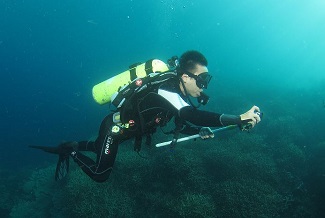
The long section wall here is dusted with parallel deposits of sand and is relatively barren for Gorontalo. Below the 30-meter mark, the wall becomes a gentle slope protruding into the current. As the current speeds up, look for large Trevally (Caranx spp.) and large Emperors (Lethrinus spp.). They will rise to feed in the current. With time almost over, notice a narrow cavern and then a small divided point spilling down the lower wall onto the steep slope. Lastly, inspect a tall, narrow cavern. Ascend slowly for the safety stop at the reef crest.
Traffic Circle Dive Site
This site is located within Olele Village Marine Park. Miguel’s Diving pays the designated fee for guests to dive here. The village residents are proud that divers come from far away. The beautiful reef and wall the sits just in front of their houses. One glance confirms that they continue to protect the site’s corals. Hard coral coverage is over 80%. The site contains two ridges of coral that protrude into the long shore current. Schools of fish will gather at one or both of these locations. Many of these fish feed on plankton that drift by. Currents often reverse. On a typical dive the lower current carries divers past the two ridges. Then, the surface current returns everyone to the mooring buoy where the dive boat waits.
This site is about 250 meters long.
Depth: 2 – 40 meters
Wall Diving Indonesia Highlights from Gorontalo: magnificent Salvador Dali sponges, schools of fish, including several snapper species, sea turtle and spectacular coral growth
Conditions: Visibility is typically 20 meters.
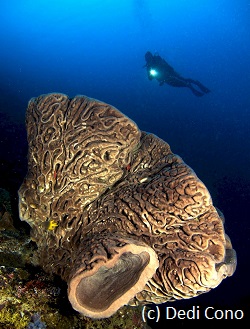
Special Note: The strange morphology of Petrosia lignosa that we call Salvador Dali sponge is only found in Gorontalo. This sponge itself is incredibly hard. But it has two vulnerabilities. If its skin is torn by a careless fin kick, the skin tears. Even worse is someone grabbing one with a glove, This skin damage allows bacteria inside. Fish begin to eat away at it. This injury can be life threatening. The other vulnerability is its fragile base and carefully weighted position. These huge sponges tend to grow below 20 meters. Wave action usually cannot snap them off the wall at this depth. Please be careful with your fins. If a Salvador Dali sponge should fall, the once majestic and strong sponge can no longer eat. It will disintegrate into dust within a few weeks.
Virtual Wall Diving Indonesia in Gorontalo
Back roll into deep blue water and follow your guide along the reef crest. Wall diving Indonesia features hard corals. Those on this wall comes in countless variety. The wall is absolutely packed with them. A small school of batfish wiggle their tails. They descend away as you approach. A single Midnight snapper swims right up to the dive guide, as if to say hello. Then it turns descends back into the blue, casting its golden eye towards the new visitors.
Ahead a gigantic mound of Galaxy coral dominates the landscape. At his signal, descend with your guide to view a gigantic Salvador Dali sponge. Next to is grows a Pink sea fan so large that no Pygmy seahorse could ever get its tail around any of its branches. Around another point is the famous Salvador Dali sponge shaped like a flower. It measures about a meter and a half in diameter.
Even though the current is pushing against divers, your guide insists that you follow him. Wise divers will follow his profile exactly. He knows best how and where to advance against the current. Once over a ridge of coral, magnificent schools of fish gather to feed. These include snappers, triggers, fusiliers, butterflyfish and clusters of belligerent trevallys.
Traffic Jam Dive Site
Wall diving Indonesia is at its best here. This spectacular coral wall has ten deep vertical chutes cut into its surface.
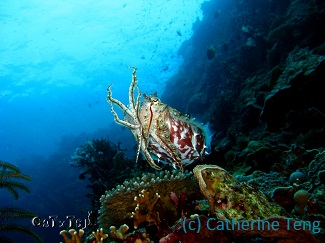
These begin at the shallow reef crest and drop to the wall’s bottom. These narrow cuts are only large enough for one diver at a time to enter. Below in deeper water, the shy and singular Blue-lined grouper (Plectopomus oligocanthus) hovers. These are a threatened species worldwide. Its dark brown body is splashed with blue scrawling. If you linger at a particular spot or swim close to the wall, carefully note your surroundings. Giant moray eels (Gymnothorax javanicus) are often sighted here. The wall also attracts large marine life, such as rays, Hawksbill sea turtle (Eretmochelys imbricata) and tuna. This is the favorite dive site of Gorontalo’s first governor Fadel Muhammad.
This site is about 400 meters long.
Depth: 3 – 40 meters
Wall Diving Indonesia Highlights from Gorontalo: millions of fish, wall cut by numerous chutes, dense coral growth, giant sponges
Conditions: Visibility is typically 20 meters. The current usually presents no problem. Sometimes, it can become quite strong during the course of a dive. Please follow your guide.
Special Note: Northern Sulawesi has the highest marine biodiversity on the planet. This Gorontalo dive site provides dramatic proof. Take your time to enjoy the site.
Virtual Wall Diving Indonesia in Gorontalo
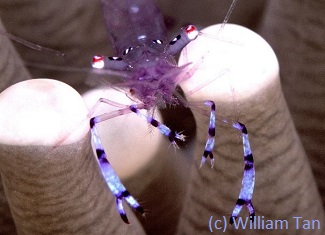
Because of the height of the adjacent mountain, direct sunlight is late hitting the wall. About mid-dive, suddenly a sun-filled gentle slope spills down the wall. This slope is about 50 meters wide and is flanked by large inlets. This slope protrudes significantly from the wall. The current here is much stronger. But the stronger current also draws significantly higher numbers of fish. Expect five species of fusiliers, unicornfish, Schooling pyramid butterflyfish (Hemitaurichthys polylepis), chromis, damsels, and anthias. This is a good place to look for Orang-back wrasse (Cirrhilabrus aurantidorsalis). This species is considered endemic to Tomini Bay and only named in 1999. Enjoyo the shallow reef crest during your safety stop. The coral growth is amazing. During your surface interval, find out if the crew has seen dolphin or the shell of a Chambered nautilus (Nautilus pompilius).
